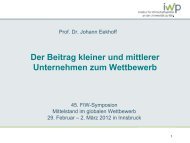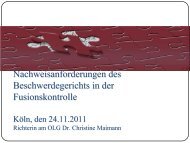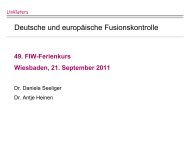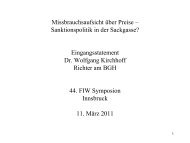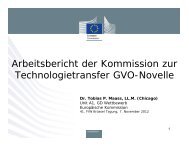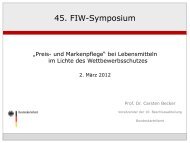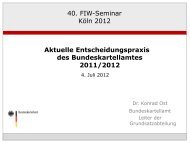What are copyright levies?
What are copyright levies?
What are copyright levies?
You also want an ePaper? Increase the reach of your titles
YUMPU automatically turns print PDFs into web optimized ePapers that Google loves.
Copyright Copyright Levies:<br />
Levies:<br />
barriers barriers to to trade<br />
trade<br />
and and and and innovation<br />
innovation<br />
Analysis under EC Competition Law<br />
Javier Ramirez<br />
Legal Director, Hewlett-Packard Europe<br />
Professor, Instituto de Empresa (IE) Law School<br />
February 27th, 2009<br />
2<br />
Agenda<br />
Part 1: <strong>What</strong> <strong>are</strong> <strong>copyright</strong> <strong>levies</strong>?<br />
- EU Legal Framework<br />
Part 2: <strong>What</strong> <strong>are</strong> the main issues?<br />
- Copyright <strong>levies</strong> as barriers to trade and innovation<br />
Part 3 – Legal Assessment<br />
- Free Circulation of Goods<br />
- EC Competition Law
Part 1<br />
<strong>What</strong> <strong>are</strong> <strong>copyright</strong> <strong>levies</strong>?<br />
• “Rough justice” national systems intended to compensate IP right-holders for<br />
(genuine) private copying based on the premise that an act of private copying<br />
cannot be licensed for practical purposes by the relevant right-holders.<br />
- Fee on products/media which <strong>are</strong> suitable/intended for (private) copying<br />
- Sound, audio-visual, literacy (including images)<br />
- To be paid by national manufacturers /importers (indirect compensation)<br />
- To collection societies (acting for authors, artists and producers/publishers)<br />
- Rates (and products) fixed by Government, by Collective Societies or others<br />
3<br />
- Some sales may be exempted<br />
• Originates in Germany (Copyright Act 1965 ) but has spread across EU:<br />
- Austria (1980), Finland (1984), France (1985), Netherlands (1990), Spain (1992),<br />
Denmark (1992), Italy (1992), Belgium (1994), ….<br />
• Distribution to right-holders varies per country (and collecting societies):<br />
Part 1<br />
- Management fees / Social and Cultural Funds<br />
- Distribution to members , non-members and other collecting societies<br />
(reciprocity agreements)<br />
EU Legal Framework - Directive 29/2001<br />
• Art. 5.2.b: Private copying exception<br />
- reproductions on any medium,<br />
- by a natural person,<br />
- for private use and for ends that <strong>are</strong> neither directly or indirectly commercial,<br />
- on condition rightholders receive “fair compensation“,<br />
- which takes into account the application or non-application of TPMs<br />
• Recital 35: Criteria when determining fair compensation<br />
• Harm to the right-holders (resulting strictly from private copying) – Recital 38<br />
• Payments received in some other form (for instance, as part of a license fee,<br />
so that no specific or separate payment may be due)<br />
• Degree of use of technological protection measures (“TPMs”)<br />
• No obligation for payment in those situations where the prejudice<br />
to the rightholder would be minimal (“de minimis” rule)<br />
4<br />
4
Part 1<br />
EU Legal Framework - Directive 29/2001<br />
• Additional provisions<br />
• Reprography exception: article 5.2.a<br />
� Reproduction on paper or similar medium; and<br />
� By photographic technique or process with similar effects<br />
• TPMs protected against circumvention: article 6<br />
• Three-steps test: article 5.5<br />
• Transposition deadline: December 22, 2002<br />
• International obligations<br />
5<br />
Part 1<br />
- Art. 9.1 TRIPs Agreement<br />
- Art. 9 Berne Convention<br />
- Art. 10 WCT<br />
- Art. 16 WPPT<br />
- Art. 15 Rome Convention (1961)<br />
Contracting parties may provide<br />
for (private use) exceptions to<br />
exclusive reproduction right, but<br />
do not require for compensation<br />
<strong>What</strong>’s the magnitude of <strong>levies</strong> system(s)?<br />
“In principle, a total of over 6% of all intra-EU imports and exports, amounting in<br />
total to over € 100 billion, <strong>are</strong> goods which actually or potentially attract a levy.”<br />
Source: EC Internal Market, “Background Document – Fair Compensation for Acts of Private Copying” (February 14, 2008)<br />
http://ec.europa.eu/internal_market/<strong>copyright</strong>/docs/levy_reform/background_en.pdf<br />
Sound and Audiovisual Levies<br />
(reported by Collecting Societies)<br />
(Source: GESAC, EC Consultation on Levies - April 08)<br />
+ Estimate Germany (~ €165M): ~ €560M<br />
+ Estimate Reprography (~30%EU) =: ~ €168M<br />
6<br />
TOTAL = ~ €728M<br />
Collectable <strong>levies</strong> + Disputed <strong>levies</strong> forecast<br />
(reported by ICT industry- Nathan Associates)<br />
(Source: CLRA, EC Consultation on Levies - April 06)<br />
NOTE: Comparable data reported by Nathan Associates Inc.<br />
(“Economic Impact Study Private Copying Levies on Digital Equipment and Media”)
Part 1 Example: Some EU Financials for<br />
Deductions and Bilateral Agreements<br />
7<br />
Part 2<br />
7<br />
Note: partial information,<br />
including only some<br />
audio & video <strong>levies</strong> in Member<br />
States (not all collecting societies<br />
included; reprography <strong>levies</strong> not<br />
included)<br />
Source: EC - “Stakeholder<br />
Consultation on Copyright Levies<br />
on a Converging World”<br />
(June 2006)<br />
<strong>What</strong> <strong>are</strong> the main issues that can affect trade?<br />
Copyright <strong>levies</strong> may be a valid tool to fairly compensate IP rightholders. However,<br />
the existing system is not aligned with Community law and needs (major) adjustments.<br />
Issue 1: Different systems with different parameters per Member State:<br />
8<br />
1.1) Legal uncertainty on applicability of <strong>levies</strong><br />
1.2) Legal uncertainty on levy applicable per device in multiple countries<br />
Issue 2: Disparate and Excessive <strong>levies</strong>, not corresponding to economic value of<br />
private copying, which incite market distortion and incentive gray market<br />
Issue 3: Administrative burdens: problems for levy classification (importation) and<br />
refund (exportation)<br />
Issue 4: Levy fees based on technical specifications acting as a barrier to innovation
Part 2 – Issue 1 (Legal Uncertainty)<br />
National approach to <strong>levies</strong><br />
9<br />
9<br />
Member<br />
State<br />
Levies Member<br />
State<br />
Austria Latvia<br />
Belgium Lithuania<br />
Bulgaria Luxembourg No Levies<br />
Cyprus No <strong>levies</strong> Malta No Levies<br />
Czech Rep. Netherlands<br />
Denmark Poland<br />
Estonia Portugal<br />
Finland Romania<br />
France Slovakia<br />
Germany Slovenia<br />
Greece Spain<br />
Hungary Sweden<br />
Ireland No Levies United Kingdom No <strong>levies</strong><br />
Italy<br />
Part 2 – Issue 1 (Legal Uncertainty)<br />
<strong>What</strong>‘s an audio / video recording device<br />
intended / suitable for private copying?<br />
Cassette-deck VCR<br />
Dedicated CD/DVD burner<br />
CD/DVD Media?<br />
Audio/Video vs. DATA<br />
Digital Camera?<br />
10<br />
PC CD/DVD<br />
data burners?<br />
Digital Pictures Frame?<br />
Memory<br />
cards?<br />
Multimedia<br />
mobile phone?<br />
• <strong>What</strong> if devices include TPMs?<br />
Levies<br />
Burner for Camera?<br />
• <strong>What</strong> if devices <strong>are</strong> for business use?<br />
PDA with<br />
integrated phone?
Part 2 – Issue 2 (Disparate and Excessive Levies)<br />
Wide disparities on <strong>levies</strong> accross Europe<br />
Response from the Commission to MEP Question (17 Jan. 2008)<br />
11<br />
Part 2 – Issue 2 (Disparate and Excessive Levies)<br />
Assessment of “economic value“<br />
of private copying<br />
“The current levy systems <strong>are</strong>, as<br />
we all know, both complex and<br />
controversial. Not alone <strong>are</strong> there<br />
huge differences in rates applying<br />
to the same or similar equipment<br />
used for private copying – there is<br />
no uniformity among Member<br />
States in setting <strong>levies</strong> for identical<br />
digital equipment. The result is a<br />
huge array of different <strong>levies</strong><br />
imposed on the same products<br />
across Europe – with differences<br />
in <strong>levies</strong> of up to 1500% applied<br />
to identical products.”<br />
• Levies not based on “harm“ principles and “the minimis“ rules, but on income<br />
expectations and bargaining power.<br />
• Harm assessment, if any, does not take into account “genuine private copying“<br />
but usually:<br />
12<br />
(i) “copies“ (consideration of copying behaviors falling outside the<br />
scope of the exception); and<br />
(ii) assumptions of copying behaviours (suitability and potential maximum<br />
capacity of the device)<br />
• Levies not based on assessment of “economic value“ (harm) of private<br />
copying<br />
� Value of a private copy should be lower than the monopolistic price<br />
(IP royalties) that right-holders would perceive for each authorized<br />
reproduction of the original work
Part 2 – Issue 2 (Disparate and Excessive Levies)<br />
E-2864/07EN<br />
Answer given by Mr McCreevy (Internal Market EU Commissioner)<br />
on behalf of the Commission (September 19 th , 2007)<br />
The notion of "fair compensation" has been introduced by Directive 2001/29 (hereafter<br />
"the Directive") as a mean to compensate owners of <strong>copyright</strong> for acts that fall under the<br />
private copying exception.<br />
(…)<br />
According to the Commission's initial analysis of the issue, only media and equipment<br />
that can be used, and <strong>are</strong> effectively used to a significant extent to produce genuine private<br />
copies can attract a levy.<br />
It also believes that equipment that is used for commercial<br />
purposes (e.g. in companies, public administrations) should<br />
not attract a levy since this would clearly go beyond<br />
requirement to provide for the compensation for permitted<br />
acts (i.e. private copying) as laid down in the Directive.<br />
- QUESTION:<br />
http://www.europarl.europa.eu/sides/getDoc.do?type=WQ&reference=E-2007-2864&language=EN<br />
- ANSWER:<br />
http://www.europarl.europa.eu/sides/getAllAnswers.do?reference=E-2007-2864&language=EN<br />
13<br />
Part 2 – Issue 2 (Disparate and Excessive Levies)<br />
Price differences<br />
(Example: pricing at Bechtle website)<br />
The Netherlands<br />
http://www.bechtle.nl/shop/MasterServlet;jsessionid=81f5ccd06dd3758b1df81ee1d2baf5cfd081b4c74c4cb2622e1129e411319265?hy<br />
bris_jakarta=81f5ccd06dd3758b1df81ee1d2baf5cfd081b4c74c4cb2622e1129e411319265&i=ls1&newFE=false<br />
Belgium https://www.bechtle.be/shop/MasterServlet;jsessionid=148fb590f6df5de47c10a2cf8acdf519aec50cd07646ea5171ad644ced9d72<br />
5c?hybris_jakarta=148fb590f6df5de47c10a2cf8acdf519aec50cd07646ea5171ad644ced9d725c&i=pr2&newFE=false<br />
14<br />
169%
Part 2 – Issue 2 (Disparate and Excessive Levies)<br />
Levy as an incentive<br />
to Gray Market (max. 3% <strong>levies</strong>)<br />
• Within an internal market shipping<br />
cost becomes the key commercial<br />
argument for intra community trade.<br />
• Levies higher than 3% start to<br />
incent arbitrage and attract free<br />
riders from no/low levy countries to<br />
ship into high levy countries –<br />
without complying to local rules.<br />
• Barriers to gray market <strong>are</strong> weak:<br />
1) Self-reporting obligation<br />
2) Liability only on 1st tiers<br />
(with country exceptions)<br />
3) “hit and run“ companies<br />
15<br />
Part 2 – Issue 2 (Disparate and Excessive Levies)<br />
Gray market in Europe<br />
16<br />
Source: EICTA (April 2008)<br />
Cost structure of Mail Order<br />
[% of end-user price]<br />
Order mgmt./<br />
overhead<br />
Delivery<br />
Telesales (O/I)<br />
Field sales<br />
incl. KAM/web-sales<br />
Marketing<br />
incl. CRM<br />
Source: Final tier interviews, Roland Berger<br />
15.2%<br />
W<strong>are</strong>house 3<br />
1<br />
3<br />
2.9<br />
0.3<br />
5<br />
MO
Part 2 – Issue 3 (Admin Burden)<br />
Example (imports): wide disparities on <strong>levies</strong><br />
clasiffication for multifunctional printers (MFPs)<br />
• No <strong>levies</strong> on MFPs in 15 Member States<br />
• Levy based only on copying speed in 2 Member States<br />
(Belgium, Slovenia) � … and how copying speed is<br />
measured?<br />
• Germany (08-10): Flat levy for inkjet and speed-based levy<br />
for laser MFPs<br />
• Levy defined as a % of import /sale price in 6 Member<br />
States (0.5% - 5.26%)- Austria, Bulgaria, Greece, Poland,<br />
Romania, Slovakia<br />
• Other approaches:<br />
− Czech Rep.: Fix levy for products in a range of prices<br />
− Hungary: combination of speed + a 2% price<br />
maximum cap<br />
− Spain: weight criteria (17 kg) + standard copying<br />
speed above 17 kg<br />
17<br />
Part 2 – Issue 3 (Admin Burden)<br />
Levies as barriers to export<br />
Double-Payments<br />
Notes:<br />
SPAIN<br />
Split of<br />
Levy on<br />
DVD burners<br />
Books<br />
Right-holders<br />
Sound<br />
Right-holders<br />
Audiovisual<br />
Rigth-holders<br />
% of the<br />
3.4€ levy<br />
1,1% -<br />
0,0374€<br />
29,08% -<br />
0,98872€<br />
69,82% -<br />
2,37388€<br />
Category<br />
of<br />
Right-<br />
holders<br />
Authors<br />
&<br />
Publishers<br />
% among<br />
each<br />
category - €<br />
100% -<br />
0,0374€<br />
Authors 50% -<br />
0,49436€<br />
Artists 25% -<br />
0,24718€<br />
Producers 25% -<br />
0,24718€<br />
Authors 33% -<br />
0,7913€<br />
Artists 33% -<br />
0,7913€<br />
Producers 33% -<br />
0,7913€<br />
Collecting<br />
Society<br />
invoicing the<br />
levy sh<strong>are</strong><br />
CEDRO (100%)<br />
(collects also on<br />
behalf of<br />
VEGAP)<br />
SGAE (100%)<br />
AIE (100%)<br />
AGEDI (100%)<br />
SGAE (~99%)<br />
DAMA (~1%)<br />
AISGE (~80%)<br />
AIE (~20%)<br />
EGEDA (100%)<br />
1. Resistence from some collecting societies to reimburse 2nd tier resellers upon exportation<br />
(directly or indirectly)<br />
2. Export refund scheme not available in various Member States<br />
18
Part 2 – Issue 3 (Admin Burden) + Legal Uncertainty<br />
Levies as barriers to multicountry<br />
e-commerce platforms?<br />
• Application of <strong>levies</strong> based on country of<br />
destination? GESAC’s proposal<br />
(EC Consultation on Levies – April 2008)<br />
http://ec.europa.eu/internal_market/<strong>copyright</strong>/levy_reform/index_en.htm<br />
Impossibility of e-commerce platforms to deal with<br />
multi-country <strong>levies</strong> administration (levy classification,<br />
price factoring, declaration, payment, audit, …)<br />
19<br />
Part 2 – Issue 4 (barrier to innovation)<br />
Impact of <strong>copyright</strong> <strong>levies</strong><br />
on product innovation<br />
• Legal uncertainty on applicability<br />
of <strong>levies</strong> on cross-border sales<br />
� Opus GmbH Case (The Netherlands)<br />
- Court of Justice in The Hague (July 12, 2007)<br />
- Court of First Instance of The Hague<br />
(Sept. 16, 2005)<br />
� Rue de Commerce Case (France)<br />
- Cour de Cassation (Nov. 27, 2008)<br />
- Cour D’Appel de Paris (March 22, 2007)<br />
- Tribunal de Commerce de Bobigny<br />
(Sept 15, 2005)<br />
� ZPU vs. Luxemburg e-retailer<br />
- LG State Court Köln<br />
(January 2008)<br />
• While schemes in several Member States <strong>are</strong> migrating to flat-fee <strong>levies</strong> (i.e.<br />
3.4€ per MP3/MP4 player) or a % price based levy (i.e. 2% import price),<br />
schemes based on technical product specs may hinder availability of<br />
innovative products:<br />
20<br />
o Higher storage capacity may drive higher <strong>levies</strong><br />
o Higher copying speeds may drive higher <strong>levies</strong><br />
o Presence of an specific functionality may attract <strong>levies</strong><br />
• Some products <strong>are</strong> not available in the EU market because potential <strong>copyright</strong><br />
<strong>levies</strong> made them unviable from a commercial perspective.<br />
• Some capabilities of certain products may be capped by manufacturers to<br />
attract lower <strong>levies</strong> and make them commercially viable (in the country or EU).<br />
• Copyright <strong>levies</strong> detract major funding from R&D activities.
Part 2 – Issue 4 (barrier to innovation) + a factor of competitiveness<br />
Example: PC-connected MFP<br />
(product re-design specific for German market - July 08)<br />
Levies on 1-12 ppm 13-35 ppm<br />
Color InkJet All-in-Ones (disputed) €76.70 €102.26<br />
Scanner levy (agreed in the past)<br />
(PC-connected copying color AiOs)<br />
Keystone Control Panel<br />
21<br />
Part 2<br />
22<br />
1 Select Start PC Copy<br />
€10.23<br />
(x7.5 times)<br />
2<br />
€31.96<br />
(x3 times)<br />
Inkjet MFP Levy<br />
USB Connected Computer<br />
3<br />
21<br />
Copy Application automatically starts<br />
on computer and begins the scan<br />
The scan finishes and the<br />
image is sent to the printer<br />
• (1995-2007): under litigation<br />
• (2008-2010): 12€ (settled<br />
since Dec. 08)<br />
Each €1 Charged in Copyright Levies Imposes a €2 Cost<br />
on the European Economy Through Lost Sales and Competitiveness<br />
Source: Nathan Associates (May 2006)<br />
NB: Based on <strong>levies</strong> currently applied in 2005. Claimed but<br />
disputed <strong>levies</strong> in 2005 amounted to an additional €2.3 billion<br />
61,63%<br />
38,37%<br />
http://www.bsa.org/eupolicy/press/newsreleases/pressrelease16may2006nathanstudyclra.cfm
Part 3<br />
Legal Assessment of Copyright Levies<br />
23<br />
Part 3<br />
1.- Some Thoughts on Free Circulation of Goods<br />
(Articles 28-30 ECT)<br />
2.- Some Thoughts under Article 81 ECT<br />
3.- Some Thoughts under Article 82 ECT<br />
4.- Some Thougths under Article 86 ECT<br />
Single Market and Copyright Levies (1)<br />
• Directive 29/2001: main goal to ensure a proper functioning of the internal<br />
market (see Recitals 1 and 31, inter alia)<br />
• Implementation of “fair compensation” must be compatible with the EC Treaty.<br />
• Prohibition of measures having an equivalent effect to quantitative restrictions on<br />
imports and exports.<br />
24<br />
�� Power of collecting societies to require an additional payment upon<br />
importation in another Member State?: No - GEMA case (C-55 and 57/80)<br />
� Consent from right-holders for <strong>levies</strong> paid in another Member State by<br />
virtue of bilateral agreements?<br />
� Note that ICT devices do not incorporate IP works or subject matters<br />
(sound recordings, …)<br />
� Heavy administrative and financial burdens on (intra-community) imports<br />
and exports of ICT devices subject to <strong>levies</strong> in import / export countries<br />
23
Part 3<br />
Single Market and Copyright Levies (2)<br />
• Art. 30 ECT permits restrictions on grounds of the protection of industrial and<br />
commercial property, but <strong>copyright</strong> <strong>levies</strong> (for private copying / reprography):<br />
25<br />
� Do not fall within the “specific subject matter” of <strong>copyright</strong>:<br />
� There is not commercial explotation of the “compensation” in the form of licenses?;<br />
� Rightholders retain the right to exploit their reproduction right commercially;<br />
� Directive provides for “fair compensation” but is neutral on the form of<br />
compensation (do not require to be provided in the form of <strong>levies</strong>);<br />
� Directive acknowledges that in several cases no compensation is due;<br />
� International <strong>copyright</strong> agreements acknowledge the exception, but not the<br />
compensation (different to “equitable remuneration” concept);<br />
� Levies not (directly) paid by those “copying” + income used also for social and<br />
cultural purposes;<br />
� There is not a “right to make private copies” (but an optional exception)<br />
� Fail the tests of (i) Necessity, (ii) Proportionality, and (iii) Non-Discrimination<br />
• Art. 30 is a derogation from fundamental EC principles to be interpreted narrowly<br />
(e.g. Case C-362/88, para. 19)<br />
Part 3<br />
Application of EC Competition Law<br />
• Art. 30 cannot restrict the application of EC Competition Law<br />
(Consten and Grundig, Joined Cases 56 and 58/64 [1966], ECR 299)<br />
� Distinction between the “existence” and the “exercise” of rights<br />
Deutsche Grammophon case (C-78/70) [application of competition rules]<br />
Some key variables for EC Competition Law Assessment<br />
(1) <strong>What</strong>’s the role of collecting societies to define what products <strong>are</strong> subject to <strong>levies</strong> and<br />
what fees have to be paid (and what criteria <strong>are</strong> followed for this definition)?<br />
(2) <strong>What</strong> is the scope of the private copying exception? (relevant copying to calculate<br />
“economic value”)<br />
(3) <strong>What</strong> categories of sales <strong>are</strong> expressly excluded from <strong>levies</strong> and how these<br />
exceptions <strong>are</strong> implemented? (business users, …)<br />
(4) How <strong>levies</strong> <strong>are</strong> collected and distributed (including cross-national distribution) among<br />
right-holders?<br />
(5) Are collecting societies authorized (by law or by-laws) to deduct any % of the<br />
collected amount for cultural and collective purposes?<br />
� Relevant Market: national market of collective management of IP rights related to<br />
compensation for private copying?<br />
26
Part 3<br />
Potential assessment under Article 81<br />
• Territorial allocation?: “Network effect” of bilateral agreements / concerted practices<br />
between collecting societies (or an association’s decision) leading to:<br />
(1) an allocation of national markets (market partitioning effect);<br />
(2) the impossibility of negotiating a unique EU-wide / multi-country <strong>copyright</strong> levy<br />
with the most efficient collecting society(ies); and<br />
(3) the charging of higher <strong>levies</strong> in respect of the same act in different Member States.<br />
[see EC decision COMP/C2/38.698 – CISAC)<br />
• Price-fixing?: Different collecting societies representing different right-holders (e.g.<br />
authors, artists and producers of sound works) negotiating together and agreeing on the<br />
levy fee to be applied, precluding individual negotiations with each category of right-holders<br />
(authors / artists / producers) separately.<br />
� Information exchange network between collecting societies (European-wide)<br />
• Other?: discriminatory treatment, joint litigation on “disputable devices”, agreements to<br />
apply <strong>levies</strong> on sales to professional end-users; (...)?<br />
27<br />
Part 3<br />
Exemption under Article 81.3?<br />
(e.g. IFPI Simulcasting decision case COMP/C2/38.014)<br />
Potential assessment under Article 82<br />
QUESTION: Is Article 82 ECT applicable when the collecting society has<br />
autonomy to (i) request either statutory <strong>levies</strong> or lower <strong>levies</strong> unilaterally<br />
determined, (ii) freely interpret the criteria to assign the levy to the device<br />
(for example, methodology to calculate relevant copying speeds), or<br />
(iii) widely interpret what a “recording device” subject to <strong>levies</strong> is?<br />
� Competition rules apply in case legal framework does not preclude collecting<br />
societies from engaging on autonomous conduct.<br />
EC decision - COMP/38.784 (Wanadoo vs Telefónica):<br />
“(666) In this respect, the Court of Justice and the Court of First Instance have<br />
consistently held that competition rules may apply where sector specific legislation does<br />
not preclude the undertakings it governs from engaging in autonomous conduct that<br />
prevents, restricts or distort competition 715.”<br />
28<br />
715 Court of Justice in Joined Cases C-359/95 and C-379/95 P Commission and France vs.<br />
Ladroke Racing [1997] ECR I-6225, paragraph 34; Court of First Instance in Case T-228/97<br />
Irish Sugar vs. Commission [1999] ECR II-296, paragraph 130; Court of First Instance in Case<br />
T-513 Consiglio Nazionale degli Spedizionieri Doganali [2000] II-1807, paragraphs 59 et seq.
Part 3<br />
Potential assessment under Article 82<br />
• Abusive pricing?: <strong>levies</strong> not related to “economic value”, higher than <strong>levies</strong> charged by<br />
other collecting societies for objectively comparable behavior.<br />
� <strong>What</strong>’s the economic value of a “private copy”?<br />
� <strong>What</strong>’s the amount of private copying with each device?<br />
� Application of private copying <strong>levies</strong> on sales to business users, where economic<br />
value of “private copying” is theoretically zero?<br />
�� Are there “double payments”?<br />
29<br />
� Reference to tech specs that <strong>are</strong> non-relevant<br />
• Discriminatory pricing?: collecting societies treating like situations in an unlike<br />
manner or unlike situations in a like manner, without objective justification<br />
� Discrimination as between importers<br />
� Discrimination as between product types (same functionality with different <strong>levies</strong>;<br />
different functionalities with same levy)<br />
• Others?: retroactive claims on devices already sold; impossibility to make effective <strong>levies</strong><br />
exemptions / refunds; seeking approval of unfair legal framework; (...)<br />
Part 3<br />
Potential assessment under Article 86<br />
Source: EC’ Stakeholder Consultation “Fair Compensation<br />
for Acts of Private Copying” (February 2008)<br />
30<br />
• Collecting societies as undertakings<br />
granted with special or exclusive rights?<br />
� EC Communication on Management<br />
of Copyright: review under Article 86<br />
where a collecting society is<br />
constituted as a legal monopoly or<br />
granted special rights under national<br />
law (paragraph 3.5.1).<br />
� Concerted practice to limit<br />
establishment of other societies?<br />
• Measures facilitating infringement of<br />
Articles 12, 28-29, 81-82 ECT<br />
• GT-Link A/S v DSB (Case C-242/95)<br />
• Social / cultural funds:<br />
• Discrimination per nationality?<br />
• Effects on competition among<br />
collecting societies?
A vision: Levies in the Single Market<br />
• A “one-stop shop” scheme where:<br />
31<br />
� Copyright <strong>levies</strong> <strong>are</strong> negotiated and agreed with most-efficient collecting societies<br />
that redistribute <strong>levies</strong> to other societies (bilateral agreements).<br />
� Levies paid only once; no levy-reassesment once devices <strong>are</strong> put into circulation in<br />
the Internal Market and moved from country to country.<br />
� “Fair compensation” based on economic value of relevant genuine private copying<br />
for the concerned devices<br />
� Single fee may result of a combination of each relevant country particularities<br />
(~ Simulcasting decision) or a uniform multi-country levy rate (~ Cannes Agreement<br />
decision).<br />
� “Fair compensation” does not become a factor of distortion in the common market.<br />
• Additional alternatives to be considered, including refinement of<br />
current levy system (e.g. levy collection at retail level with no <strong>levies</strong> on<br />
professional sales; no double payment for “licensed copies”; …), or<br />
different compensation schemes (e.g. State funds like in Norway).<br />
32<br />
javier.ramirez2@hp.com
BACK-UP SLIDES:<br />
• Spain: example of reporting, payment and distribution functioning<br />
• Example: example of magnitude of disputed <strong>levies</strong><br />
• Prejudicial questions on <strong>copyright</strong> <strong>levies</strong> refered to the ECJ<br />
• Legends and notes to slide 9<br />
• Calculation of economic value of private copying<br />
• Size of gray market (<strong>levies</strong> unpaid) for recordable media in Europe<br />
• Example of continuous developments / changes on national <strong>levies</strong><br />
• Some courts decisions on application of <strong>levies</strong> on online cross-border sales<br />
• Example: impact of assigning conventional photocopiers <strong>levies</strong> + draft copying speed<br />
for calculation of consumer inkjet MFPs <strong>levies</strong> (Germany – 2007)<br />
• Nathan Associates Study - Economic Impact of Copyright Levies (May 2006)<br />
• Recitals 1 and 31 Directive 29/2001<br />
• Reference to some ECJ judgments concerning <strong>copyright</strong> and Internal Market<br />
• Example of Bilateral Agreements on Reprography<br />
• Example: EC Competition Law (GT-Link A/S v DSB (Case C-242/95).<br />
33<br />
Part 1<br />
An example: Spain<br />
• Importation of 10,000 DVD burners for<br />
integration by PC manufacturers<br />
Levies liability upon shipment to PCmakers<br />
or resellers<br />
(10,000 units x 3.4€ = 34,000€ )<br />
• Obligation to invoice <strong>levies</strong> to buyers<br />
• Obligation to report <strong>levies</strong> quarterly to<br />
(national) collecting societies<br />
• Obligation to pay within one month after<br />
reporting period.<br />
• Exemption for subsequent shipments to<br />
other Member States?<br />
• Distribution:<br />
34<br />
• 20% deduction (10 % social funding<br />
and 10% cultural funding)<br />
• management fee (~10-13%)<br />
• members / non-members /<br />
other collecting societies<br />
(bilateral agreements)
Part 1<br />
An example: Germany<br />
(collected vs. disputed <strong>levies</strong>)<br />
Source: EURIMAG – Response to the European Commission “Second Call for Comments on<br />
Fair Compensation for Acts of Private Copying” (April 2008)<br />
35<br />
Part 1 & 2 - Legal Framework and Excessive Levies<br />
36
Part 2 – Issue 1 (Legal Uncertainty)<br />
Legends to Slide 9<br />
37<br />
Sound and audivisual <strong>levies</strong> on recordable media<br />
(including in some cases storage media / memory integrated<br />
in recorders, such as TV hard-disc recorders)<br />
Additional sound and audiovisual <strong>levies</strong> on hardw<strong>are</strong> operated<br />
with recordable media<br />
Book related <strong>levies</strong> (under reprography / private copying)<br />
Note: Countries may additionally distinguish between “intended” vs.<br />
“suitable” devices, single-purpose vs. multi-purpose devices, analogue vs.<br />
digital; etc, and no national system is identical to another one.<br />
Part 2 – Issue 2 (Excessive Levies)<br />
Which proxy should be used in<br />
determining the value of a private copy?<br />
• Private copying is an exception to the exclusive right. Therefore the value of a<br />
private copy should be lower than the monopolistic price (IP royalties) that<br />
right-holders perceive for each authorized reproduction of an original work.<br />
Cfr. Copyright Board Canada, levy decisions on audio recording media:<br />
http://www.cb-cda.gc.ca/decisions/copying-e.html<br />
38<br />
“In the Board’s view, if there were a free market for private copies,<br />
the price paid for the underlying intellectual property would be much lower than<br />
royalties paid for top-line recordings. It is not reasonable to assume that<br />
consumers would pay as much for the underlying rights in a private copy of a CD<br />
they already own; on this point, the Board agrees with Professor Brander. It<br />
is also not reasonable to assume that there is a one-to-one correlation between<br />
lost sales and private copying activity. Economic theory tells us that faced with<br />
such market conditions, rights owners would lower their prices in order to<br />
maximize their revenues.”
Part 2 – Issue 2 (Excessive Levies)<br />
Which proxy should be used in<br />
determining the value of a private copy?<br />
“Private Copying, Appropriability, and<br />
Optimal Copying Royalties”<br />
39<br />
By: Stanley Besen, Sheila Nataraj Kirby<br />
http://wwwcgi.rand.org/pubs/reports/R3546/<br />
Part 2 – Issue 2 (Disparate and Excessive Levies)<br />
Gray market in Europe<br />
40<br />
Source: RIAE - EC’ Stakeholder Consultation “Fair Compensation for Acts of Private Copying<br />
(February 2008)
Part 2 – Issue 3 (Admin Burden)<br />
Example: Levies under continuous changes<br />
41<br />
Part 2 – Issue 3 (Admin Burden) + Legal Uncertainty<br />
Source: EICTA (April 2008)<br />
Levies as barriers to multicountry<br />
e-commerce platforms?<br />
• Rue de Commerce Case (France)<br />
• First Instance: Commercial behavior of UK and German<br />
defendants in their intent to sell products to French<br />
consumers over Internet without paying <strong>levies</strong> do not<br />
qualify as unfair competition, but not informing<br />
consumers about their potential obligation to pay those<br />
<strong>levies</strong> do qualify.<br />
• Appeal:<br />
- Copyright <strong>levies</strong> differences among Member States<br />
create price differences across EU.<br />
- Internet retailer is not the importer and therefore not<br />
liable to French <strong>levies</strong>.<br />
- No unfair competition exists even when the lack of<br />
payment of <strong>levies</strong> has an impact on consumer choice.<br />
• Supreme Court:<br />
- Consumers <strong>are</strong> theoretically liable for levy payment on<br />
online imports.<br />
- Foreign online merchants must disclose that <strong>levies</strong> <strong>are</strong><br />
not included in the price<br />
42<br />
•Opus GmbH Case (The Netherlands)<br />
- Parties with residence in different Member<br />
States can agree where the products <strong>are</strong><br />
delivered and who should take c<strong>are</strong> of<br />
transportation (and be legally deemed as<br />
“importer” subject to payment of <strong>levies</strong>).<br />
- Consumers who can be seen as importers <strong>are</strong><br />
not obliged to pay <strong>levies</strong> under Dutch law.<br />
- Even in case Opus GmbH had been in charge<br />
of transportation, it would be the “exporter” and<br />
not the “importer” (the meaning of import –<br />
shipping over and within the borders – shows<br />
that the importer is in the country of import)
Part 2 – Issue 4 (barrier to innovation) + a factor of competitiveness<br />
Example: impact of assigning conventional<br />
photocopiers <strong>levies</strong> + draft copying speed for<br />
calculation of consumer inkjet MFPs <strong>levies</strong><br />
43<br />
Part 2<br />
44<br />
Levy Claimed (Draft Speed)<br />
Net Dealer Price<br />
102,26 €<br />
45,00 € 53,00 € 60,00 € 61,00 €<br />
HP Deskjet F2180<br />
All-in-One<br />
102,26 €<br />
HP Deskjet F380 Allin-One<br />
102,26 € 102,26 €<br />
HP Deskjet F4180<br />
All-in-One<br />
HP Deskjet F375 Allin-One<br />
102,26 € 102,26 €<br />
74,00 € 75,00 €<br />
HP Photosmart<br />
C3180 All-in-One<br />
HP Photosmart<br />
C4180 All-in-One<br />
Levy claimed on best-sellers HP models with average<br />
Dealer Net Price between 45€ - 96€ in Germany in 2007<br />
44<br />
102,26 €<br />
96,00 €<br />
HP Photosmart<br />
C4380 All-in-One<br />
• Direct economic effect of <strong>levies</strong> is<br />
higher than the amount of <strong>levies</strong><br />
collected<br />
• Impact of <strong>levies</strong> is higher when the<br />
elasticity of demand is higher<br />
A = Amount of levy<br />
collected when levy<br />
was imposed<br />
B= Increase in the welf<strong>are</strong><br />
of consumers upon levy<br />
removal<br />
C= Gain in producers<br />
revenue upon levy<br />
removal
Part 3<br />
Single Market and Copyright Levies (1)<br />
• Directive 29/2001/EC<br />
(1) The Treaty provides for the establishment of an internal market and the institution of a<br />
system ensuring that competition in the internal market is not distorted. Harmonisation<br />
of the laws of the Member States on <strong>copyright</strong> and related rights contributes to the<br />
achievement of these objectives. (…)<br />
(31) A fair balance of rights and interests between the different categories of rightholders,<br />
as well as between the different categories of rightholders and users of protected<br />
subject-matter must be safeguarded. The existing exceptions and limitations to the rights<br />
as set out by the Member States have to be reassessed in the light of the new electronic<br />
environment. Existing differences in the exceptions and limitations to certain restricted<br />
acts have direct negative effects on the functioning of the internal market of <strong>copyright</strong><br />
and related rights. Such differences could well become more pronounced in view of the<br />
further development of transborder exploitation of works and cross-border activities.<br />
In order to ensure the proper functioning of the internal market, such exceptions and<br />
limitations should be defined more harmoniously. The degree of their harmonisation<br />
should be based on their impact on the smooth functioning of the internal market.<br />
45<br />
Part 3<br />
Single Market and Copyright Levies (2)<br />
• Dassonville (Case 8/74 [1974] ECR 837, para.5)<br />
“5. All trading rules enacted by Member States which <strong>are</strong> capable of hindering, directly or indirectly,<br />
actually or potentially, intra-Community trade <strong>are</strong> to be considered as measures having an equivalent<br />
effect to quantitative restrictions.”<br />
• Musik-Vertrieb Membran v GEMA (Cases 55 and 57/80 [1981] ECR 147)<br />
“14 The argument put to the Court by the Belgian and Italian Governments that in the absence of<br />
harmonization in this sector the principle of the territoriality of <strong>copyright</strong> law always prevails over the principle<br />
of freedom of movement of goods within the common market cannot be accepted. Indeed, the essential<br />
purpose of the Treaty, which is to unite national markets into a single market, could not be attained if, under<br />
the various legal systems of the Member States, nationals of those Member States were able to partition the<br />
market and bring about arbitrary discrimination or disguished restrictions on trade between Member States.<br />
(…)<br />
18. It should be observed next that no provision of national legislation may permit an undertaking which is<br />
responsible for the management of <strong>copyright</strong>s and has a monopoly on the territory of a Member State by<br />
virtue of that management to charge a levy on products imported from another Member State where they<br />
were put into circulation by or with the consent of the <strong>copyright</strong> owner and thereby cause the Common<br />
Market to be partitioned. Such a practice would amount to allowing a private undertaking to impose a<br />
charge on the importation of sound recordings which <strong>are</strong> already in free circulation in the Common Market<br />
on account of their crossing a frontier; it would therefore have the effect of entrenching<br />
the isolation of national markets which the Treaty seeks to abolish.”<br />
46
Part 3<br />
Single Market and Copyright Levies (3)<br />
• Deutsche Grammophon v Metro (Case 78/70 [1971] ECR 487)<br />
“11. Amongst the prohibitions or restrictions on the free movement of goods which it<br />
concedes Article [30] refers to industrial and commercial property. On the assumption that<br />
those provisions may be relevant to a right related to <strong>copyright</strong>, it is nevertheless clear from<br />
that article that, although the Treaty does not affect the existence of rights recognized by the<br />
legislation of a Member State with regard to industrial and commercial property, the exercise<br />
of such rights may nevertheless fall within the prohibitions laid down by the Treaty. Although<br />
it permits prohibitions or restrictions on the free movement of products, which <strong>are</strong> justified for<br />
the purposes of protecting industrial and commercial property, Article [30] only admits<br />
derogation from that freedom to the extent to which they <strong>are</strong> justified for the purpose<br />
safeguarding rights which constitute the specific subject matter of such property.”<br />
47<br />
• Industrial and commercial property: “includes the protection conferred by <strong>copyright</strong>, especially<br />
when exploited commercially in the form of licenses capable of affecting distribution in the various<br />
Member States of goods incorporating the protected literary or artistic work.” (Musik-Vertrieb<br />
Membran v GEMA (Cases 55 and 57/80 [1981] ECR 147, paragraph 9).<br />
• Specific subject matter: “the right to exploit commercially the marketing of the protected product,<br />
particularly in the form of licenses granted in return for the payment of royalties“ (Phil Collins and<br />
others; Joined cases C-92/92 and C-326/92 [1993] ECR I-5145, paragraph 20).<br />
Part 3<br />
Example - Network of Bilateral Agreements<br />
for Reprographic related Rights<br />
48<br />
http://www.ifrro.org<br />
Right-holders represented by other collecting<br />
societies (Germany, Austria, Belgium, …)<br />
consent to the Spanish fees (or even a lower<br />
amount after deductions) as “fair compensation”<br />
for copies of their works made in Spain.
Part 3<br />
Example - Network of Bilateral Agreements<br />
for Reprographic related Rights<br />
http://www.ifrro.org<br />
SAMPLE – Bilateral Agreement Type A and Type B<br />
“1.- LICENCE/AUTHORITY TO COLLECT<br />
On behalf of the rightsholders it represents, Society A hereby grants to Society B the nonexclusive<br />
right to enter into licensing agreements with users and to collect fees for the<br />
reprographic reproduction in Territory B of the rights, works and publications as described<br />
in Schedule A to this Agreement on the same basis and on the same conditions as Society B<br />
licenses and collects fees for reprographic reproduction of the rights, works and publications of the<br />
rightsholders it represents. (...)”<br />
• Bilateral Agreement TYPE A: Implies transfer of funds between collecting societies<br />
• Bilateral Agreement TYPE B: Implies retention of funds by each collecting society<br />
SAMPLE – Bilateral Agreement Type B<br />
“8. FUNDS<br />
Each RRO agrees that:<br />
1. Fees collected by Society B for reprographic reproduction of works and publications as set out in<br />
Clause 1 of this agreement will be retained by Society B.<br />
2. Fees collected by Society A for reprographic reproduction of works and publication<br />
as set out in Clause 2 of this agreement will be retained by Society A.”<br />
49<br />
EC Competition Law (1)<br />
• GT-Link A/S v DSB (Case C-242/95. [1997], ECR I-4449)<br />
“33 The Court has previously had occasion to rule that any measure adopted by a Member State<br />
which maintains in force a statutory provision that creates a situation in which a public<br />
undertaking cannot avoid infringing Article [82] of the Treaty is incompatible with the rules of the<br />
Treaty (see, to that effect, Case C-41/90 Höfner and Elser [1991] ECR I-1979, paragraph 27).<br />
34 In particular, a Member State infringes the prohibitions laid down in Article [86(1)] and Article<br />
[82] of the Treaty if, by adopting rules governing the port duties to be paid for the use of ports<br />
belonging to a public undertaking, it induces that undertaking to abuse the dominant position it<br />
occupies within the common market or a substantial part of it (see, to that effect, Case C-18/93<br />
Corsica Ferries [1994] ECR I-1783, paragraph 43). (…)<br />
38 Second, it should be noted that, according to Article [82(a) and (c)], an abuse of a dominant<br />
position may consist of directly or indirectly imposing unfair purchase or selling prices or other<br />
unfair trading conditions or applying dissimilar conditions to equivalent transactions with other<br />
trading parties, thereby placing them at a competitive disadvantage.<br />
39 The Court has ruled that `unfair prices', for the purposes of Article [82(a)], means prices which<br />
<strong>are</strong> excessive because they have no reasonable relation to the economic value of the service<br />
supplied (see, to that effect, United Brands, paragraph 250). (…)<br />
50
EC Competition Law (2)<br />
(…)<br />
45 The Court has already held that abusive practices which, like those at issue in the main<br />
proceedings, affect undertakings providing transport by sea between two Member States,<br />
may affect trade between Member States (Corsica Ferries, paragraph 44).<br />
46 In the light of those considerations, the reply to the sixth and eighth questions must be<br />
that where a public undertaking which owns and operates a commercial port occupies a<br />
dominant position in a substantial part of the common market, it is contrary to Article<br />
[86(1)] in conjunction with Article [82] of the Treaty for that undertaking to levy port duties<br />
of an unreasonable amount pursuant to regulations adopted by the Member State to which<br />
it is answerable or for it to exempt from payment of those duties its own ferry services and,<br />
reciprocally, some of its trading partners' ferry services, in so far as such exemptions entail<br />
the application of dissimilar conditions to equivalent services. It is for the national court to<br />
determine whether, having regard to the level of the duties and the economic value of the<br />
services supplied, the amount of duty is actually unfair. It is also for the national court to<br />
determine whether exempting its own ferry services, and reciprocally those of some of its<br />
trading partners, from payment of duties in fact amounts to the application of dissimilar<br />
conditions to equivalent services.”<br />
51<br />
FURTHER READINGS:<br />
• EC Internal Market: Stakeholders Consultations on Copyright Levies (2006 and 2008) and<br />
Member States Consultation (2004)<br />
http://ec.europa.eu/internal_market/<strong>copyright</strong>/levy_reform/index_en.htm<br />
• Impact Assessment – Commision Staff Working Document – Fair Compensation for Private<br />
Copying in a Converging Environment (xx.12.2006)<br />
• EICTA – Copyright Levies Working Group (2008) - http://www.eicta.org/index.php?id=885<br />
• Nathan Associates Inc.- “Economic Impact Study, Private Copying Levies on Digital<br />
Equipment and Media - Direct Effects on Consumers and Producers and Indirect Effects on<br />
Sales of Online Music and Ringtones” (May 2006)<br />
http://www.bsa.org/eupolicy/press/newsreleases/pressrelease16may2006nathanstudyclra.cfm<br />
• “No Place Like Home for Making a Copy: Private Copying in European Copyright Law and<br />
Consumer Law” By Natali Helberger & P. Bernt Hugenholtz (2007) – See additional reports<br />
http://www.ivir.nl/staff/hugenholtz.html<br />
• Econlaw.- “Economic Analysis of Private Copying Remuneration“ – Sept. 2007<br />
http://www.gesac.org<br />
52



